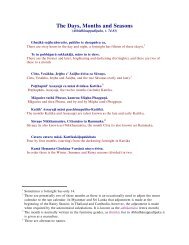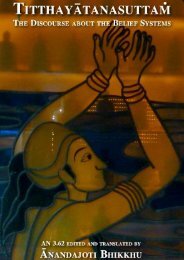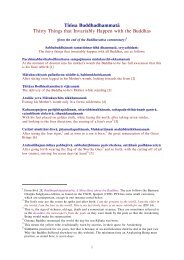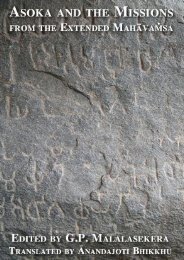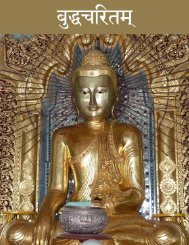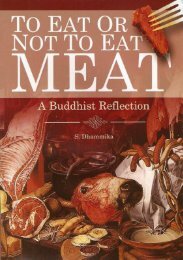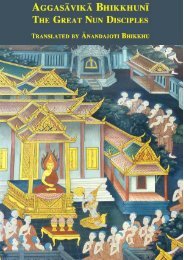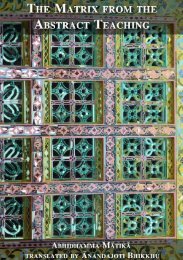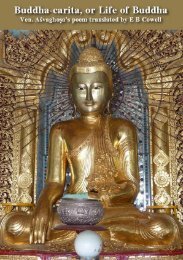MahÄkhandhako The Great Chapter - Ancient Buddhist Texts
MahÄkhandhako The Great Chapter - Ancient Buddhist Texts
MahÄkhandhako The Great Chapter - Ancient Buddhist Texts
You also want an ePaper? Increase the reach of your titles
YUMPU automatically turns print PDFs into web optimized ePapers that Google loves.
<strong>The</strong> <strong>Great</strong> <strong>Chapter</strong> - 28<br />
catuddisā cattāro selamaye patte Bhagavato upanāmesuṁ:<br />
brought from the four directions four bowls made of (green) stone 65 to the Gracious<br />
One (saying):<br />
“Idha Bhante Bhagavā paṭiggaṇhātu manthañ-ca madhupiṇḍikañ-cā.” ti<br />
“Please accept, venerable Sir, Gracious One, the milk-rice and honey-balls here (in<br />
the bowls).”<br />
Paṭiggahesi Bhagavā paccagghe selamaye patte<br />
<strong>The</strong> Gracious One accepted in the new bowl 66 made of stone<br />
manthañ-ca madhupiṇḍikañ-ca, paṭiggahetvā ca paribhuñji.<br />
the milk-rice and honey-balls, and having accepted (it) he ate.<br />
Atha kho Tapussabhallikā vāṇijā Bhagavantaṁ etad-avocuṁ:<br />
<strong>The</strong>n the merchants Tapussa and Bhallika said this to the Gracious One:<br />
“Ete mayaṁ Bhante Bhagavantaṁ saraṇaṁ gacchāma Dhammañ-ca,<br />
“We, venerable Sir, are those who go to the Gracious One for refuge, and to the<br />
Dhamma, 67<br />
upāsake no Bhagavā dhāretu ajjatagge pāṇupete saraṇaṁ gate,” ti<br />
please bear in mind that we are lay disciples who have gone for refuge from today<br />
forward for as long as we have the breath of life,”<br />
te ca loke paṭhamaṁ upāsakā ahesuṁ dvevācikā.<br />
and they became the first lay disciples in the world with the two(-refuge) formula. 68<br />
Rājāyatanakathā Niṭṭhitā<br />
<strong>The</strong> Story about the Royal (tree) is Finished<br />
65 Comm: muggavaṇṇaselamaye patte; bowls made of rock coloured like green peas.<br />
Jayawickrama (SGB) translates as granite, though that rock is not green. <strong>The</strong> commentary<br />
and Jā Nid mention that first the four kings brought a sapphire (indanīlamaṇimaya) bowl,<br />
but the Gracious One would not accept it, presumably because jewelled bowls are not<br />
allowed in the Vinaya (see Cullavagga Khuddhakavatthukkhandhakaṁ, 8), but there only<br />
two bowls are allowed, those made of iron (ayo) and of earthenware (mattika).<br />
66 Comm: Gahetvā ca pana cattāro pi yathā eko va patto hoti tathā adhiṭṭhahi; having taken<br />
the four (bowls they) became as one bowl through determining. Paccagghe is explained as<br />
meaning either precious (its normal meaning) or new in the commentary, it seems the latter<br />
is intended here.<br />
67 <strong>The</strong>re was still no Saṅgha at that time, so they took the double refuge; in Mahāvastu, on the<br />
contrary they go for refuge in the Three Treasures.<br />
68 Comm: Atha Bhagavā sīsaṁ parāmasi, kesā hatthe laggiṁsu, te tesaṁ adāsi: “Ime tumhe<br />
pariharathā” ti. Te kesadhātuyo labhitvā, Amateneva abhisittā, haṭṭhatuṭṭhā Bhagavantaṁ<br />
vanditvā pakkamiṁsu; then the Gracious One brushed his head and hair stuck to his hand,<br />
and he gave it to them (saying): “Take this with you.” After receiving the hair relics,<br />
consecrated by the Deathless, joyful and satisfied, and worshipping the Gracious One, they<br />
departed. Same story in Jā Nid.




